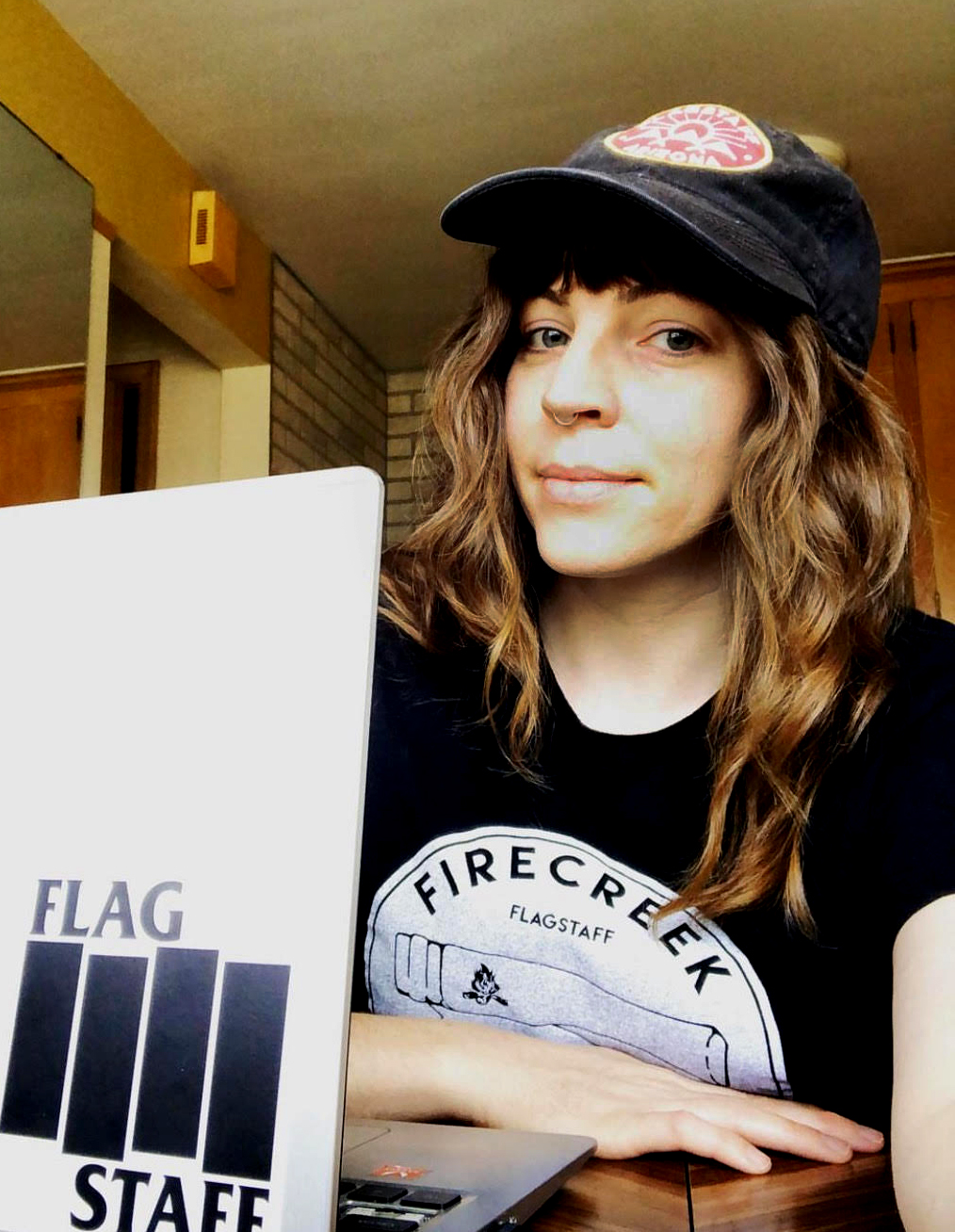
Chelsey Burden writes about landscapes, both outer and inner. “In my work, the desert landscape comes up often, and I’m usually writing about the emotional landscape of issues around autonomy, sexism and mortality.” Poetry becomes a means to reconcile the internal and external points of view. “The boundary between the two feels very nebulous and permeable. External images act as a reflection for internal experiences that would otherwise be invisible.”
Chelsey’s poems have been published in many journals and she is the author of a poetry chapbook, Thorax Carnival from Dancing Girl Press. Her poem “The Girl Among the Geese” won Vocal’s After the Parade prize. She received an MFA in creative writing from NAU after completing BAs in sociology and women/gender studies. “I’m very curious about why society functions the way it does, and I wanted to get a deeper understanding of social problems to then figure out how I could best be of service.” That led to her work in libraries over the past 15 years.
Writing, though, has always been a part of Chelsey’s life. “I wrote poetry from age five or so. My parents read to me a lot and really encouraged early literacy, which is one of the best things you can do for your kids. I’ve always been highly sensitive, so I appreciated the comfort of the written word, and then being the one doing the writing gave me a sense of agency and self-connection.” She even discovered an early poem written in the second grade: rattlesnake waits quietly / SNAP! / It strikes poor rabbit. / Then all is quiet again. She adds, “I haven’t changed.”
Chelsey finds poetry to be both personal and universal, private and public. “If I think too much about the reader, inspiration eludes me and the writing feels flat and forced. But if I don’t consider the reader at all, what connection am I offering? The poems I feel best about began as very private and personal, but then were edited with an awareness of the reader.” The most successful poems act as conduits between writer and reader. “Poetry is transformational. It’s a bridge between people, a direct line between hearts.”
Chelsey’s roots are in the Mohave Desert. “I grew up in Kingman, then moved to Flagstaff when I was 18 and stayed there till I was 31. I love the mountains and forests of Flagstaff so much.” She now lives in Minneapolis, where she works at a children’s-book publisher. “I visit Arizona a few times a year, and it will always be my home.”
Inspiration for new poems can turn up anywhere for Chelsey. “A recent poem, ‘Ode to My Apartment Neighbors,’ came as a knock on my door letting me know/ the washing machine is now open. It emerged as I reflected on the connective tissue of people who live in close quarters. Especially in this digital age, I think a lot about community in the sense of the people physically around you.”
“I’ve always loved Sylvia Plath. She seems to give real weight to female pain in a world that doesn’t take it seriously. Mary Oliver offers so much comfort by naming what’s already waiting in the natural world. Andrea Gibson is so accessible to so many people, which is something I admire.”
In the following poem, “Litany of Lovers and Weather,” Chelsey expands on her theme of landscapes. “The external and internal landscapes naturally speak to each other. It’s especially apparent when two people’s internal landscapes are externalized in a clash of some sort. The wreckage left behind by people reminded me of storms and vice versa.” She feels that poems in general tap into many subconscious associations. “Imagery enters as a language of its own, especially when personal emotional language is inaccessible to the individual. Religious imagery emerges often. I think it’s the symbolism the collective unconscious is swimming in.”
Ultimately for Chelsey, poetry is a way to find common ground with others. “At weddings and funerals, people turn to music and poetry. I think these forms are ancient and applicable to all people, and they are there for us during the most emotionally intense times as an anchor, a guide, a comfort.”
More at chelseyburden.wordpress.com.
Of course we are storms, passing through
the landscapes of one another.
How else would that bottle
have turned into glass shards, triangular
and scattered like shining confetti?
How else would those sheets have become
soaked through? From the salt and water
of the sweat of the body or
deliverance from black rain clouds.
How else would that drywall have borne
holes? Debris white as knuckle bone.
Or consider the creation
of crow’s feet on flightless faces
and crooked lines of furrowed brows,
deepening with repetition, etched
like washes in the desert.
Of course we are storms and landscapes.
How else would the blood of others
have come down on me in droplets?
Like the storms that have lifted up,
then torn apart, frogs and catfish,
carried their remains through the air,
like a funeral procession.
How else would old letters
have ended up in the trashcan?
Or like the storm they say poured out
periwinkle and hermit crabs:
the consciousness of someone else?
fragmented, shaken, raining down.
Of course we are storms and landscapes.
The dawn after the storm has passed,
these memories litter the land,
hanging exposed, raw broken nerves.
The snapped branches, the fallen trees,
the puddles that gather and cling.
The clouds that fade like old bruises.
The dark wet tint of roof tiles
and pavement, dampened as if with
watercolors. And most of all,
the soggy earthworms who emerge,
lengthening their pallid bodies.
Murmuring yes, we have smelled death.
And we’ve eaten it.
You can name us resurrection.
Dee Cohen is a Prescott poet and photographer. deecohen@cox.net.